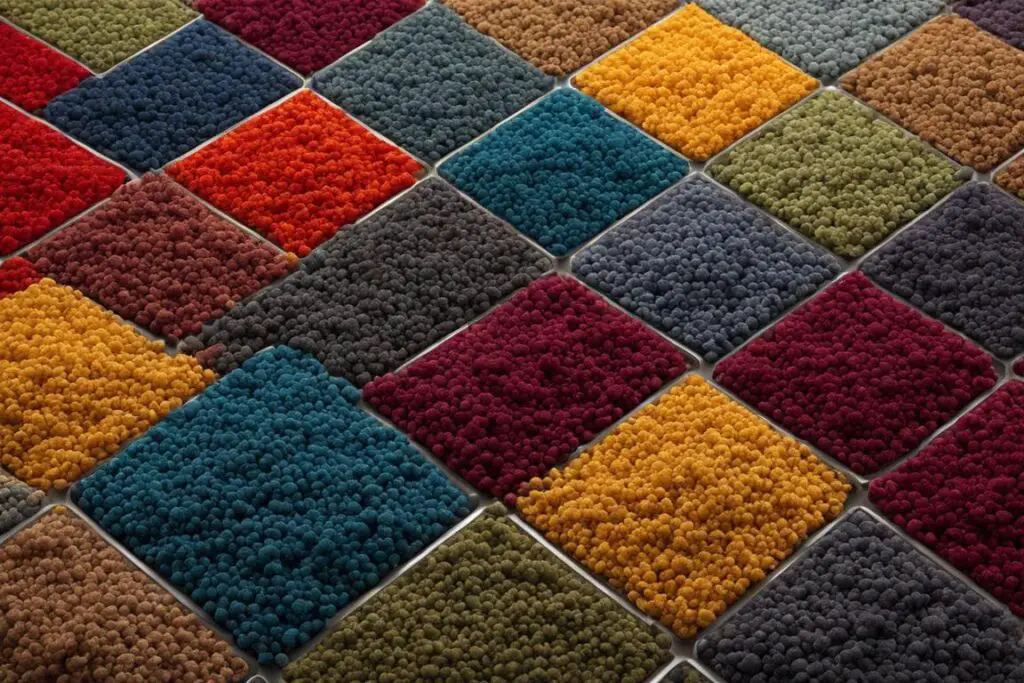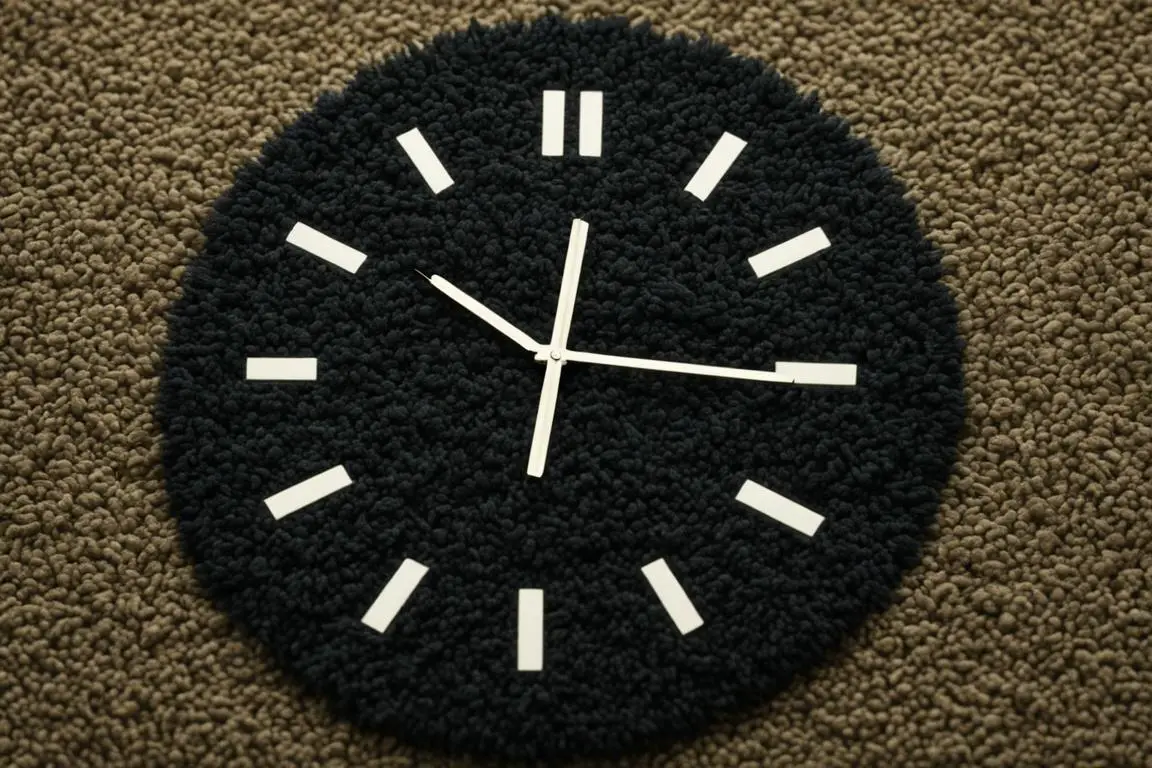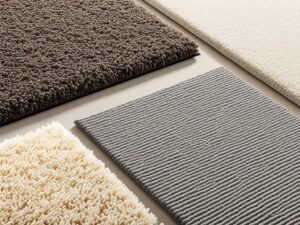Welcome to Freshen Up, your go-to source for tips and advice on maintaining a fresh and clean home environment. In this article, we will address a common concern: the duration of new carpet smell. Many individuals wonder how long this odor lasts and what steps they can take to eliminate it. Join us as we explore the factors influencing carpet odor duration and provide actionable tips to reduce and eliminate new carpet smell.
Key Takeaways:
- Understanding the causes of new carpet smell, primarily volatile organic compounds (VOCs) released during off-gassing.
- Proper ventilation and adherence to manufacturer guidelines are crucial in minimizing carpet odor duration.
- Choosing low-VOC or VOC-free carpets and adhesives can help reduce new carpet smell and create a healthier indoor environment.
- Additional methods such as vacuuming, steam cleaning, sprinkling baking soda, and using air purifiers can aid in eliminating the odor.
- Specific carpet odors, such as smoke, mildew, pet urine, and sweat smells, require targeted treatments for effective removal.
Causes of New Carpet Smell
The smell of new carpet is a common occurrence that many people experience when they install new carpets in their homes. This distinct odor is primarily caused by volatile organic compounds (VOCs) that are released as the carpet off-gasses. VOCs are organic chemicals that have a high vapor pressure at room temperature, which means they easily evaporate into the air and contribute to indoor air pollution.
There are several sources of VOCs in new carpets. One major source is the synthetic latex used in the carpet backing. Synthetic latex is a material that is derived from petrochemicals and can contain various chemical compounds that contribute to the odor. Additionally, the padding and adhesives used during carpet installation can also release VOCs, including chemical residues from dyes, water repellents, anti-static agents, and other additives used in carpet manufacturing.
The Role of Synthetic Latex
Synthetic latex is commonly used in carpet backing because of its durability and moisture resistance. However, it can also release VOCs as it breaks down over time. These VOCs contribute to the new carpet smell and can persist for a period after installation.
Chemical Residues and Dyes
The dyes and auxiliaries used in carpet manufacturing can also emit VOCs when the carpet off-gasses. These chemicals, which are used to achieve the desired color and properties of the carpet, can release small amounts of volatile organic compounds into the air, contributing to the overall smell.
Reducing VOC Emissions
While it is challenging to completely eliminate the new carpet smell, there are steps you can take to reduce VOC emissions and minimize the duration of the odor. One effective approach is to choose carpets that have low VOC emissions. Look for carpets that are labeled as low-VOC or VOC-free, as these have undergone testing to meet strict emission standards. Additionally, using low-VOC adhesives during installation can help minimize the release of VOCs.
Proper ventilation is also important in reducing new carpet smell. Ensure that the room is well-ventilated during and after carpet installation by opening windows and using fans to increase airflow. This allows the VOCs to disperse more quickly, helping to minimize the odor.
Overall, understanding the causes of new carpet smell, such as VOCs from synthetic latex, chemical residues, and dyes, can help you make informed decisions when selecting carpets and implementing strategies to reduce the duration of the odor.

| Cause of New Carpet Smell | Contributing Factors |
|---|---|
| Synthetic Latex in Carpet Backing | Release of VOCs as the latex breaks down |
| Chemical Residues | VOC emissions from dyes and auxiliaries used in carpet manufacturing |
| Padding and Adhesives | Release of VOCs from padding and adhesives |
Health Effects and Sensitivities
The release of volatile organic compounds (VOCs) from the new carpet smell typically does not pose a health risk to the average person. However, individuals who are particularly sensitive or have respiratory issues, such as asthma, may experience certain symptoms when exposed to high levels of VOCs.
Exposure to VOCs can lead to respiratory issues, including throat irritation and the exacerbation of asthma symptoms. Some individuals may also experience nausea, headaches, and dizziness as a result of VOC exposure.
To minimize any potential health effects, it is important to follow the carpet manufacturer’s guidelines for proper ventilation in newly carpeted rooms. This helps to reduce the concentration of VOCs in the air. Additionally, it is recommended to refrain from using the newly carpeted room for the recommended period of time, allowing for further dissipation of VOCs.
Choosing low-VOC or VOC-free carpets and using low-VOC adhesives during installation can also help reduce VOC exposure and improve indoor air quality. Furthermore, incorporating plants that have the ability to break down certain VOCs, such as Boston fern and spider plant, can contribute to a healthier environment.

In summary, while the health effects of new carpet smell are generally mild for most individuals, those with respiratory issues should take precautions to minimize VOC exposure. By following proper ventilation practices, selecting low-VOC products, and considering natural air purifiers, individuals can create a healthier indoor space and reduce the duration of new carpet smell.
Tips to Reduce New Carpet Smell
To reduce the duration of new carpet smell, proper ventilation is key. By following these tips, you can minimize the odor and enjoy a fresher indoor environment.
1. Proper Ventilation: Ventilate the newly carpeted room by opening windows and using fans to increase airflow. This helps disperse the volatile organic compounds (VOCs) responsible for the smell and accelerates their dissipation.
2. Choose Low-VOC Carpets: Opt for carpets that have low VOC emissions. Look for products labeled as low-VOC or VOC-free to minimize the emission of odor-causing compounds.
3. Use Low-VOC Adhesives: When installing the carpet, use low-VOC adhesives to further reduce the release of VOCs. This can help minimize the duration of the new carpet smell.
4. Vacuum Regularly: Regular vacuuming can help remove any residual odor from the carpet. Make sure to use a vacuum cleaner with a HEPA filter for better air quality.
5. Sprinkle Baking Soda: Sprinkling baking soda onto the carpet and letting it sit for 24 hours before vacuuming can help absorb some of the chemical fumes and reduce the smell.
6. Steam Cleaning: Steam cleaning the carpet is an effective method to rinse away any chemical residue that may be left in the fibers. This can help eliminate the odor and freshen up the carpet.
7. Use Air Purifiers: Consider using air purifiers with activated carbon filters to further improve the air quality and reduce the smell of new carpet. These filters can help trap and remove VOCs from the indoor air.
8. Incorporate Plants: Certain plants, such as Boston fern and spider plant, can help improve indoor air quality by breaking down certain VOCs. Adding these plants to the room can help reduce the new carpet smell.
By following these tips, you can minimize the duration of new carpet smell and enjoy a fresh and inviting space.
 <!–
<!–
| Method | Description |
|---|---|
| Proper Ventilation | Ventilate the room by opening windows and using fans to increase airflow. |
| Choose Low-VOC Carpets | Opt for carpets with low VOC emissions to minimize odor-causing compounds. |
| Use Low-VOC Adhesives | Use low-VOC adhesives during carpet installation to reduce VOC emissions. |
| Vacuum Regularly | Regularly vacuum the carpet to remove any residual odor. |
| Sprinkle Baking Soda | Apply baking soda to the carpet and let it sit to absorb chemical fumes. |
| Steam Cleaning | Steam clean the carpet to remove any remaining chemical residue. |
| Use Air Purifiers | Use air purifiers with activated carbon filters to improve air quality. |
| Incorporate Plants | Add certain plants that can help break down VOCs and freshen the air. |
–>
How to Deal with Specific Carpet Odors
Different types of odors in carpets may require specific treatments. Here are some effective methods for removing common carpet odors:
Smoke Odor in Carpet
If your carpet has a smoke smell, you can use baking soda as a natural absorbent. Sprinkle a generous amount of baking soda on the carpet and let it sit for a few hours or overnight. Then, vacuum up the baking soda to remove the smoke odor. Additionally, make sure to ventilate the room by opening windows or using fans to help eliminate the smell.
Mildew Smell in Carpet
To tackle a mildew smell in your carpet, start by drying the affected area thoroughly. Use a dehumidifier or fans to reduce moisture and promote drying. Once dry, create a solution of warm water and white vinegar. Dampen a cloth or sponge with the mixture and gently scrub the carpet. The acidity of the vinegar helps neutralize and remove the odor-causing compounds. Allow the carpet to air dry, and the mildew smell should be significantly reduced.
Basement Funk Smell
If you notice a musty or basement funk smell in your carpet, try using a peeled onion. Place the onion in a bowl or dish and leave it overnight in the affected area. Onions naturally absorb excess moisture in the air, helping to reduce the unpleasant odor. In the morning, remove the onion and ventilate the room to allow fresh air circulation.
Pet Urine Smell in Carpet
For pet urine odor, it’s important to act quickly. Firstly, soak up as much urine as possible using absorbent cloths or paper towels. Then, create a mixture of warm water, white vinegar, and baking soda. Apply the mixture to the stained area, ensuring it penetrates the carpet fibers. Afterward, blot the area dry with clean cloths or paper towels. For stubborn odors, you can also try using club soda as a spot treatment. Blot the club soda onto the carpet and then blot dry.
Sweat Smells in Carpet
To eliminate sweat smells in your carpet, you can use fabric fresheners specifically designed for carpets. Follow the instructions on the product and apply it to the carpet according to the manufacturer’s guidelines. Alternatively, you can sprinkle baking soda on the carpet and let it sit for at least 15 minutes to absorb the odor. Afterward, thoroughly vacuum the carpet to remove the baking soda and any trapped odors.
Each specific carpet odor may have different causes and solutions. By addressing the specific odor with the appropriate methods, you can effectively remove the unpleasant smells and enjoy a fresh-smelling carpet.
Tips to Prevent Carpet Odors
Preventing carpet odors is essential for maintaining a fresh and clean environment. By implementing these simple tips, you can keep your carpets smelling fresh and minimize the need for odor removal treatments.
Regular Vacuuming
Regular vacuuming is the foundation of a healthy carpet care routine. It helps remove dirt, debris, and potential odor sources from the carpet fibers, preventing odors from settling in. Aim to vacuum at least once a week, focusing on high-traffic areas and using attachments to reach crevices and corners.
Opening Windows for Fresh Air Circulation
Opening windows whenever possible allows for fresh air to circulate in your space. This helps remove stale odors and provides a refreshing environment. Whenever the weather permits, take advantage of natural ventilation and let the fresh air in.
No-Shoes Policy
Implementing a no-shoes policy can significantly reduce the introduction of outside dirt and germs to your carpets. Shoes can track in dirt, bacteria, and other odor-causing agents, leading to unpleasant smells over time. Encourage your family members and guests to remove their shoes at the entrance to keep your carpets cleaner and fresher.
Use of Dehumidifiers
Controlling humidity levels is crucial for preventing dampness and mold growth, both of which can contribute to unpleasant carpet odors. Use dehumidifiers in areas prone to high humidity, such as basements and bathrooms, to maintain optimal moisture levels and prevent the growth of odor-causing microorganisms.
Follow these tips to prevent carpet odors, and enjoy fresh-smelling carpets that contribute to a healthier and more pleasant living environment.
| Prevention Tips | Description |
|---|---|
| Regular Vacuuming | Remove dirt, debris, and potential odor sources from the carpet fibers. |
| Opening Windows | Allow fresh air circulation and removal of stale odors. |
| No-Shoes Policy | Minimize the introduction of outside dirt and germs to the carpet. |
| Use of Dehumidifiers | Control humidity levels and prevent dampness and mold growth. |
Conclusion
To conclude, new carpet smell is a common issue that can be easily tackled by understanding its causes and implementing effective odor elimination techniques. The duration of the smell can vary, but typically lasts for a few days to a few weeks. By following a few simple steps, you can enjoy fresh-smelling carpets and create a healthier indoor environment.
Using low-VOC or VOC-free carpets is crucial in reducing the emission of odor-causing compounds. Proper ventilation practices, such as opening windows and using fans, help disperse volatile organic compounds (VOCs) and accelerate their dissipation. Additionally, employing methods like steam cleaning, sprinkling baking soda, and using air purifiers with activated carbon filters can effectively eliminate the new carpet smell.
By implementing these techniques, you can say goodbye to the unpleasant odor and enjoy a fresh-smelling carpet. Remember, prioritizing indoor air quality is essential for a comfortable and healthy living space. So, take the necessary steps to eliminate new carpet smell and create a welcoming atmosphere in your home.
FAQ
How long does the smell of new carpet last?
The smell of new carpet usually lasts a few days to a few weeks as the volatile organic compounds (VOCs) in the carpet off-gas. During this time, proper ventilation and following manufacturer’s guidelines can help minimize the smell and ensure a healthier environment.
What causes the smell of new carpet?
The smell of new carpet is caused by VOCs, such as 4-phenylcyclohexene (4-PCH) and styrene, which are released as the carpet off-gasses. These VOCs come from synthetic latex in the carpet’s backing, padding, adhesives, and other chemical additives used during manufacturing.
Are there any health effects associated with new carpet smell?
While the VOCs released from new carpet smell are generally not harmful to the average person’s health, individuals who are particularly sensitive or have respiratory issues may experience symptoms like nausea, headaches, and throat irritation. It is important to follow proper ventilation practices and consider low-VOC carpets for a healthier indoor environment.
How can I reduce the smell of new carpet?
To reduce the smell of new carpet, ensure proper ventilation by opening windows and using fans to increase airflow. Choosing low-VOC or VOC-free carpets, using low-VOC adhesives, and incorporating steam cleaning, baking soda, and air purifiers can also help minimize the duration of the smell.
What can I do to eliminate specific odors in my carpet?
Different odors in carpets may require specific treatments. For smoke odor, using baking soda and proper ventilation can help eliminate the smell. Mildew smell can be treated with a mixture of warm water and white vinegar. Placing a peeled onion in the basement can help reduce basement funk smell. Pet urine odor can be addressed by soaking up the urine and using a mixture of warm water, white vinegar, and baking soda. Sweat smells in carpet can be eliminated by using fabric fresheners or sprinkling baking soda on the carpet and vacuuming it up.
How can I prevent carpet odors?
Preventive measures to minimize carpet odors include regular vacuuming, opening windows for fresh air circulation, implementing a no-shoes policy to prevent dirt and germs, and using dehumidifiers to control humidity levels and prevent dampness that can cause odors.
What is the conclusion about tackling new carpet smell?
By understanding the causes of new carpet smell and implementing proper odor elimination techniques, such as ventilation, low-VOC carpets, steam cleaning, and air purifiers, individuals can effectively reduce the duration of the smell and enjoy fresh-smelling carpets and a healthier indoor environment.



